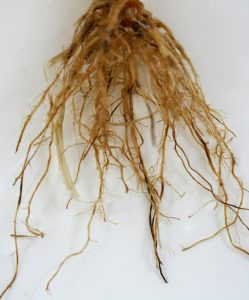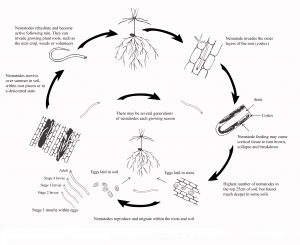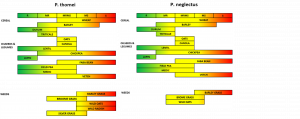The two important species of root lesion nematode (RLN) in Victorian cropping soils are Pratylenchus neglectus and Pratylenchus thornei. They often occur together. Both species can cause grain yield losses in most crops, but the greatest yield losses have been measured in wheat, barley and chickpea. Even though root lesion nematodes are present in up to 90 per cent of paddocks in Victoria, they are only present in medium to high levels in 10 to 20 per cent of paddocks. Therefore, it is important to test individual paddocks to determine if they are present at yield limiting densities.
What to Look For
In the field, above ground symptoms of root lesion nematodes include stunted plant growth, uneven patches or waviness across the paddock. The two main root symptoms include lesions or discolouration of the roots and a lack of branching along the main roots. They do not cause roots to swell, but appear brown or constricted where infestation of the root cortex has occurred. These symptoms are similar to Rhizoctonia, but the characteristic spear tipping associated with Rhizoctonia is absent.
Disease Cycle
Root lesion nematodes are worm-like organisms less than 1 mm in length which feed on and within roots.
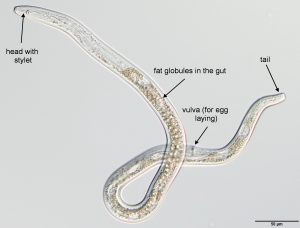
Pratylenchus thornei adult female, approximately 0.65 mm in length. Image courtesy Kirsty Owen, University of Southern Queensland
Root lesion nematodes have more than one generation per season and are able to migrate between and within the roots and soil. These nematodes survive over summer either as eggs or in a dehydrated state, becoming active again once moisture is available.
Economic Importance
In the southern region, field trials between 2012 and 2016 showed that RLN can cause yield losses of 5 to 20 per cent in cereals. The risk of yield loss increases as the number of nematodes present at sowing increases. However, the effect on crop yield depends on seasonal conditions, the crop/variety and the numbers of nematodes present at sowing. The figure below highlights the yield loss in bread wheat, in a single variety over four different seasons associated with increasing pre-plant nematode densities. The risk of yield loss is reduced in seasons when there is no moisture stress on the crop during spring.
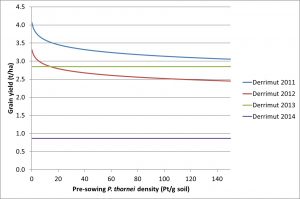
Relationship between pre-planting density of Pratylenchus thornei in the soil and grain yield of wheat (cv. Derrimut) in four different seasons in the Victorian Wimmera 2011-2014.
Management
If growing susceptible crops/varieties, a PREDICTA®B test can be used to monitor RLN populations and ensure they are not at densities known to cause yield losses. When susceptible crops are grown consecutively, they lead to high nematode populations. The yield loss caused by RLN is related to the number of nematodes present in a paddock. Rotation to resistant crops reduces root lesion nematode densities (number) in the soil and provides the best option for their control. In contrast, rotations with susceptible crops increases root lesions nematode densities and yield loss in subsequent intolerant crops. Rotations are the best way of controlling RLN.
Resistant crops can reduce nematode populations by up to 50 per cent in one year. A break of two or more years from susceptible crops may be necessary to minimise yield loss if nematode numbers were high to start with. Avoid delayed sowing of intolerant cereal crops.
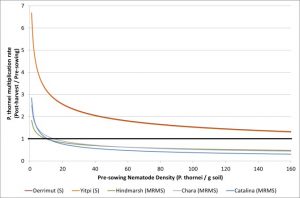
Relationship between pre-planting number of Pratylenchus thornei and their multiplication rate in the presence of five cereal varieties with contrasting resistance / susceptibility. Data based on five seasons (2011 to 2015) of field data from Banyena, Victoria.
Hosts
Root lesion nematodes have a broad host range that includes cereal and broadleaf crops. However, always check current cereal and pulse disease guides for the latest ratings.
RLNs are more likely to be a problem when:
- Susceptible varieties are grown sequentially increasing nematode numbers.
- An intolerant crop is sown, or
- Sowing is delayed.

